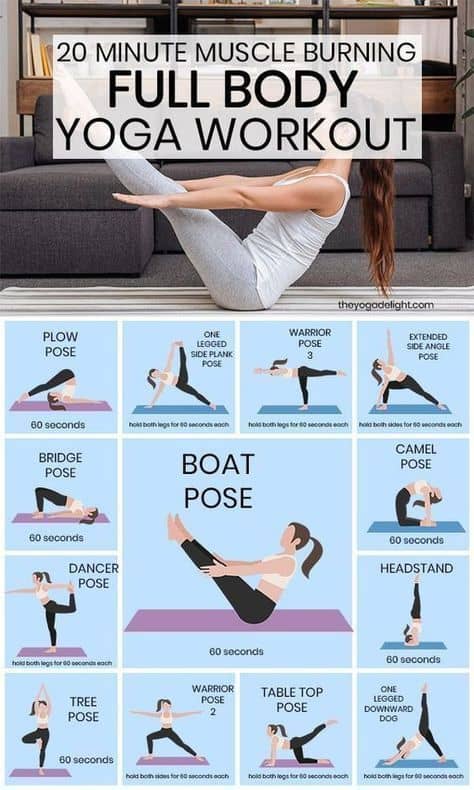20-Minute Muscle-Burning Full-Body Yoga Workout: A Comprehensive Guide to Strength, Flexibility, and Mind-Body Wellness
Looking for a quick yet effective way to build strength, increase flexibility, and boost overall wellness? You’re in the right place! In this article, we’re diving deep into a 20-minute muscle-burning full-body yoga workout that can seamlessly fit into your busy lifestyle. Whether you’re a seasoned yogi or just starting your yoga journey, this sequence of poses will challenge your muscles, enhance your balance, and bring your mind to a calmer, more focused state.
Below, we’ll break down each pose featured in the workout, provide tips for proper alignment, and highlight the benefits you can expect. We’ll also touch on how to modify these poses to suit different skill levels. By the end of this guide, you’ll have a thorough understanding of how each posture works, and you’ll be ready to roll out your mat and get moving!
Table of Contents
- Why a 20-Minute Yoga Workout?
- Essential Tips Before You Begin
- The 20-Minute Yoga Sequence Overview
- Pose-by-Pose Breakdown
- Plow Pose (Halasana)
- Bridge Pose (Setu Bandha Sarvangasana)
- One-Legged Side Plank (Vasisthasana Variation)
- Dancer Pose (Natarajasana)
- Warrior III (Virabhadrasana III)
- Extended Side Angle Pose (Utthita Parsvakonasana)
- Boat Pose (Navasana)
- Camel Pose (Ustrasana)
- Tree Pose (Vrksasana)
- One-Legged Downward Dog (Eka Pada Adho Mukha Svanasana)
- Headstand (Sirsasana)
- Warrior II (Virabhadrasana II)
- Table Top Pose (Bharmanasana)
- Frequently Asked Questions (FAQ)
- Safety Precautions and Modifications
- How to Make the Most of Your Practice
- Final Thoughts
Why a 20-Minute Yoga Workout?
In today’s fast-paced world, finding time for extensive workout routines can be challenging. However, practicing yoga doesn’t need to take hours to be effective. A structured 20-minute sequence can:
- Improve Strength and Muscle Tone: Yoga poses engage the core, legs, arms, and back in a balanced way.
- Enhance Flexibility: Even short, consistent stretches can promote long-term flexibility gains.
- Relieve Stress: Focusing on your breath and alignment can help clear your mind and reduce anxiety.
- Boost Energy: A short session can invigorate you, making you feel refreshed and more focused for the rest of your day.
- Fit Easily into a Busy Schedule: A 20-minute routine is more approachable for those with work, family, or school commitments.
By leveraging a well-rounded sequence of yoga poses, you can reap these benefits without investing hours at a time. This makes the practice sustainable, so you’re more likely to stick with it and see results.
Essential Tips Before You Begin
- Set Up a Dedicated Practice Space
Clear a small area in your home or office where you can stretch out comfortably. A yoga mat or any non-slip surface will help stabilize your poses. - Wear Comfortable Clothing
Choose clothing that allows freedom of movement. Yoga leggings or shorts and a fitted top work well to ensure you can monitor your alignment. - Warm Up
Before diving into more challenging poses like Plow Pose or Headstand, spend a few minutes gently mobilizing your joints—roll your neck, rotate your shoulders, and do light hip openers. - Hydrate
Drink water before and after your session. Although yoga is a lower-impact form of exercise, hydration is still crucial. - Listen to Your Body
If you experience discomfort, back off and reassess your posture. Never force a pose beyond your comfort level. - Focus on Breathing
Proper breathing (usually inhaling through the nose and exhaling through the nose) helps deepen stretches and enhances the relaxation response. - Have a Timer Handy
Each pose is held for about 30-60 seconds. Using a stopwatch or phone timer can keep you on track and consistent.
The 20-Minute Yoga Sequence Overview
This routine is designed to target your entire body within 20 minutes. Each pose has a specific duration that challenges your strength, flexibility, and balance. Here’s a quick overview:
- Plow Pose (Halasana) – 60 seconds
- Bridge Pose (Setu Bandha Sarvangasana) – 60 seconds
- One-Legged Side Plank (Vasisthasana Variation) – 30 seconds each side
- Dancer Pose (Natarajasana) – 30 seconds each leg
- Warrior III (Virabhadrasana III) – 30 seconds each leg
- Extended Side Angle Pose (Utthita Parsvakonasana) – 30 seconds each side
- Boat Pose (Navasana) – 60 seconds
- Camel Pose (Ustrasana) – 60 seconds
- Tree Pose (Vrksasana) – 60 seconds
- One-Legged Downward Dog (Eka Pada Adho Mukha Svanasana) – 60 seconds
- Headstand (Sirsasana) – 60 seconds
- Warrior II (Virabhadrasana II) – 30 seconds each side
- Table Top Pose (Bharmanasana) – 60 seconds
Pose-by-Pose Breakdown
1. Plow Pose (Halasana)
Duration: 60 seconds
How to Perform:
- Lie on your back, arms resting at your sides.
- Use your core to lift your legs overhead, bringing your toes toward the floor behind your head.
- Keep your legs straight if possible, knees slightly bent if necessary.
- Clasp your hands behind your back for additional support.
Benefits:
- Stretches the shoulders and spine.
- Helps improve digestion and circulation.
- Calms the mind, aiding in stress relief.
Pro Tip: Keep your neck relaxed and gaze toward your navel to avoid straining your neck.
2. Bridge Pose (Setu Bandha Sarvangasana)
Duration: 60 seconds
How to Perform:
- Lie on your back with knees bent, feet hip-width apart.
- Press your feet into the floor and lift your hips toward the ceiling.
- Interlace your fingers under your lower back, pressing your arms down for support.
- Keep your chest lifted and chin slightly tucked.
Benefits:
- Strengthens the glutes, hamstrings, and lower back.
- Opens the chest and shoulders, improving posture.
- Stimulates the thyroid gland, aiding in metabolism regulation.
Pro Tip: Press evenly through both feet to keep hips level. Avoid excessive arching in the lower back by engaging your core.
3. One-Legged Side Plank (Vasisthasana Variation)
Duration: 30 seconds each side
How to Perform:
- Begin in a full plank position with wrists under shoulders.
- Rotate onto the outside edge of your right foot, stacking your left foot on top.
- Lift your left arm toward the sky.
- Raise your left leg if you can, or keep it stacked on top of the right.
- Switch sides after 30 seconds.
Benefits:
- Targets the obliques and core stabilizers.
- Builds shoulder and arm strength.
- Improves balance and body awareness.
Pro Tip: Keep your hips lifted by drawing the waistline upward. If balance is an issue, place your top foot in front of the bottom foot or lower your top leg to the ground.
4. Dancer Pose (Natarajasana)
Duration: 30 seconds each leg
How to Perform:
- Stand tall, grounding through one foot.
- Bend your opposite knee, bringing your foot behind you.
- Grasp the inside of your foot or ankle with the same-side hand.
- Inhale and reach your free arm forward for balance as you lift your back leg.
- Switch legs after 30 seconds.
Benefits:
- Opens the chest, shoulders, and hips.
- Strengthens the standing leg’s quads, glutes, and ankles.
- Improves flexibility and coordination.
Pro Tip: Keep your gaze fixed on a stationary object (a drishti) to help with balance.
5. Warrior III (Virabhadrasana III)
Duration: 30 seconds each leg
How to Perform:
- Stand in Mountain Pose (Tadasana). Shift weight onto one foot.
- Hinge at the hips, raising your opposite leg behind you to hip height.
- Extend your arms forward, in line with your ears.
- Try to form a straight line from your fingertips to your raised heel.
Benefits:
- Strengthens the entire back body, especially the glutes and hamstrings.
- Improves core stability and balance.
- Enhances focus and concentration.
Pro Tip: Engage your core to keep your torso parallel to the floor. If you struggle with balance, rest your fingertips on a chair or place your hands at your heart center.
6. Extended Side Angle Pose (Utthita Parsvakonasana)
Duration: 30 seconds each side
How to Perform:
- From a wide-legged stance, turn your right foot out 90 degrees.
- Bend your right knee so it’s over your right ankle, forming a right angle.
- Place your right forearm on your right thigh, or place your right hand on the floor inside your foot.
- Extend your left arm overhead, creating a long line from your left heel to your fingertips.
- Repeat on the other side.
Benefits:
- Strengthens and stretches the legs, hips, and waist.
- Opens the chest and shoulders.
- Builds stamina and balance.
Pro Tip: Keep your chest open by rolling your top shoulder back and looking up at your raised hand if comfortable.
7. Boat Pose (Navasana)
Duration: 60 seconds
How to Perform:
- Sit on your mat with knees bent and feet on the floor.
- Lean back slightly, keeping your spine straight.
- Lift your feet off the floor, bringing your shins parallel to it.
- Extend your arms forward, parallel to the ground.
- Straighten your legs if possible, or keep them bent for a modified version.
Benefits:
- Targets the abdominal muscles and hip flexors.
- Strengthens the lower back.
- Improves overall core stability.
Pro Tip: Keep your chest lifted and avoid rounding your spine. If this pose is too intense, keep your hands on the floor by your hips for added support.
8. Camel Pose (Ustrasana)
Duration: 60 seconds
How to Perform:
- Kneel on your mat with knees hip-width apart.
- Rest your hands on your lower back or reach for your heels if you’re more flexible.
- Lift your chest and press your hips forward.
- Gently drop your head back if it feels comfortable.
Benefits:
- Stretches the entire front body, including the chest and hip flexors.
- Strengthens the back muscles.
- Enhances spinal flexibility and can improve posture.
Pro Tip: Engage your thighs and core to protect your lower back. If touching the heels causes strain, keep your hands on your lower back for support.
9. Tree Pose (Vrksasana)
Duration: 60 seconds
How to Perform:
- Stand tall with feet hip-width apart.
- Shift weight onto one leg and place the sole of your other foot against the inside of your standing leg (ankle, calf, or inner thigh).
- Bring your hands to your heart center or extend them overhead.
- Maintain steady, even breathing.
Benefits:
- Strengthens the legs, especially the ankles and calves.
- Improves balance and concentration.
- Encourages a sense of grounding and calm.
Pro Tip: Keep your standing leg active by lifting the kneecap and engaging your quad. Avoid placing your foot directly on your knee joint to prevent injury.
10. One-Legged Downward Dog (Eka Pada Adho Mukha Svanasana)
Duration: 60 seconds
How to Perform:
- Start in a regular Downward Dog (hips lifted, arms straight, feet hip-width apart).
- Lift one leg behind you, keeping hips level or opening the hip, depending on your preference.
- Reach through your raised heel, pressing firmly through your palms for stability.
- Switch legs halfway through (30 seconds each side).
Benefits:
- Strengthens arms, shoulders, and core.
- Stretches hamstrings and calves.
- Helps improve body alignment and posture.
Pro Tip: If your hamstrings are tight, keep a slight bend in the supporting leg. Focus on a straight spine rather than forcing your heels to the floor.
11. Headstand (Sirsasana)
Duration: 60 seconds
How to Perform (for intermediate to advanced yogis):
- Kneel on the floor. Interlace your fingers, placing your forearms on the mat.
- Rest the crown of your head against your hands.
- Lift your knees, walking your feet closer to your elbows.
- Gently lift your feet off the ground, straightening your legs overhead.
- Keep your core engaged and shoulders away from your ears.
Benefits:
- Improves balance, concentration, and blood circulation to the brain.
- Strengthens shoulders, arms, and upper back.
- Can help relieve stress and mild depression (when practiced safely).
Pro Tip: If you’re new to inversions, practice with a wall for support, or skip this pose until you build enough shoulder and core strength. Always prioritize safety.
12. Warrior II (Virabhadrasana II)
Duration: 30 seconds each side
How to Perform:
- Start in a wide stance, turning your right foot out 90 degrees.
- Bend your right knee until it’s directly over your right ankle.
- Extend your arms parallel to the floor, one forward and one back.
- Gaze over your right fingertips, maintaining a proud chest.
Benefits:
- Tones and strengthens the legs.
- Opens the hips and chest.
- Boosts stamina and mental focus.
Pro Tip: Keep your torso square to the side (not leaning forward). Relax your shoulders and extend through your fingertips.
13. Table Top Pose (Bharmanasana)
Duration: 60 seconds
How to Perform:
- Come onto all fours with hands under shoulders and knees under hips.
- Keep your back flat, neither arching nor rounding excessively.
- Distribute your weight evenly between your hands and knees.
- For added challenge, try “Bird Dog”—extend opposite arm and leg straight out.
Benefits:
- Stabilizes the core.
- Helps realign the spine after more intense backbends or twists.
- Serves as a gentle reset pose before you conclude your practice.
Pro Tip: Engage your abdominal muscles slightly to prevent your lower back from sagging.
Frequently Asked Questions (FAQ)
- Can Beginners Perform This Workout?
Yes, but proceed with caution and consider modifying advanced poses like Headstand. If you’re unsure about proper alignment, consult a qualified yoga instructor or use a wall for stability in inverted poses. - How Often Should I Practice This 20-Minute Yoga Sequence?
You can safely incorporate it 2-3 times a week. Always listen to your body and ensure adequate rest. - What If I’m Not Flexible Enough?
Yoga is a journey that meets you where you’re at. Use props like blocks, straps, or a folded towel. Over time, consistent practice will gradually improve your flexibility. - Can I Lose Weight with Yoga?
Yoga can aid in weight management by building lean muscle and promoting mindfulness around eating habits. Combine this routine with a balanced diet and other forms of exercise for best results. - Is This Routine Safe During Pregnancy?
Certain poses might not be suitable for pregnant individuals. Always consult your healthcare provider or a prenatal yoga specialist for guidance tailored to each trimester.
Safety Precautions and Modifications
- Consult a Professional: If you have any existing health concerns, injuries, or physical limitations, seek medical advice before starting a new yoga regimen.
- Use Props: Blocks, straps, or blankets can help you modify poses. For example, if you can’t reach the floor in Extended Side Angle Pose, rest your forearm on your thigh or use a block.
- Practice Near a Wall for Inversions: If Headstand or other inverted poses feel intimidating, position your mat near a wall for extra support.
- Avoid Pain: Yoga should never be painful. A mild stretch or muscle burn is fine, but sharp pain is a sign to ease off.
- Listen to Your Body: Take breaks, practice restorative poses like Child’s Pose (Balasana) if you feel fatigued.
How to Make the Most of Your Practice
- Set an Intention: Before beginning, choose a focus for your session—whether it’s improving balance, cultivating calm, or simply enjoying the present moment.
- Stay Mindful of Your Breath: Use a slow, steady breathing pattern to guide each movement. If your breath becomes rushed, pause and reset.
- Combine with Cardiovascular Activity: While yoga offers numerous benefits, pairing it with moderate cardio exercise (like brisk walking or cycling) can support heart health.
- Cool Down: After the final pose, spend a minute or two in Savasana (Corpse Pose) to help your body and mind fully relax.
- Track Your Progress: Keep a yoga journal or use a fitness app to note how long you can hold each pose and how your body feels. Small improvements over time are signs of sustainable progress.
Final Thoughts
In a world where time is at a premium, a 20-minute muscle-burning full-body yoga workout can be a game-changer for your physical and mental well-being. Each pose in this sequence targets key muscle groups while also promoting flexibility, balance, and mindfulness. As you build consistency with this short, power-packed routine, you may find improvements not only in your physique but also in your energy levels, mental clarity, and stress management.
Remember, yoga is as much about the journey inward as it is about the physical poses. By focusing on your breath, posture, and mental state, you create a practice that nurtures your entire being. Respect your limits, celebrate your milestones, and keep exploring the infinite world of yoga postures and variations.
Ready to Begin? Spread out your mat, turn on some relaxing music, and devote 20 minutes to self-care and holistic wellness. Don’t forget to share your experience and any insights you’ve gained in the comments below. Happy practicing!
Disclaimer
This article is for informational and educational purposes only. It is not intended as a substitute for professional medical advice, diagnosis, or treatment. Always consult a qualified healthcare provider before starting any new fitness or wellness program, especially if you have existing health conditions or injuries. By practicing the poses and recommendations in this article, you assume full responsibility for your own health and well-being. If you experience pain or discomfort, discontinue the exercise immediately and seek expert guidance.
Did you enjoy this post? Share it on social media and let others know how a short daily yoga routine can transform their wellness journey. Also, feel free to explore our other resources to keep expanding your practice, from foundational poses to mindfulness techniques. Namaste!










